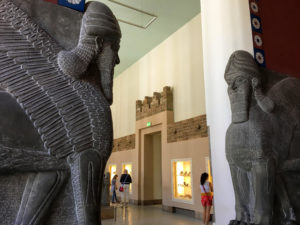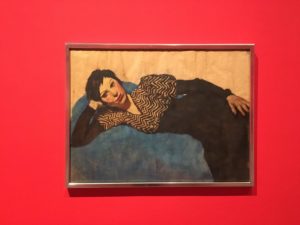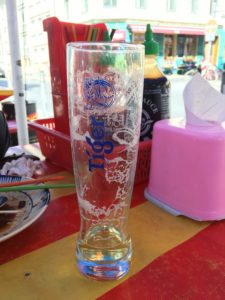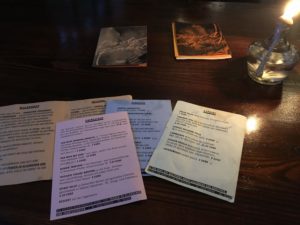
The Pergamonmuseum is filled with artworks from ancient Babylon, Islamic cultures, and classical antiquity. Photo by Lia Norton
It’s been 30 years since I was in Berlin. The Berlin Wall was about to come down, but East Germany was still hanging on and Checkpoint Charlie was still up. It was pretty grim.
Berlin, of course, has undergone tremendous changes since then, as my daughter, Lia, writes about in her first guest post for this blog. The city is now a swirl of activity, culture, and culinary experimentation.
In this post, Lia focuses on Berlin’s art and food, both of which she absorbed with gusto. For baby boomers like me who remember Berlin mostly as an outpost of the Cold War, the transformation is a revelation — I can’t wait to go back.
By Lia Norton
The last time I was in Berlin, back in 2008, it was for a scant 24 hours. I’d missed my connecting flight and had to stay over in Rome—and though I know better than to complain about an extra day in the Eternal City, I’d been itching to see more of the German capital ever since.
This June, I got my chance for a do-over—for nearly a week at that—with my partner, Mike.
Our main goals for Berlin (as for most places, really) were to see great art and eat great food. So that’s what I’ll cover in this first post, with my second focusing on the more unexpected experiences that will nevertheless go down as some of our favorites.
Kunst und Kultur (Art and Culture)
One of the few purchases I made in advance of our trip was the €29 3-Day Museum Pass, which gives visitors access to more than 30 of Berlin’s museums, big and small alike.
The pass must be used over consecutive days, but the museums are spread across the city, making them easy to seek out wherever you might find yourself during the day. And since the pass pays for itself after three museums, even a quick pop-in, like we did at the Museum für Fotografie, is both possible and encouraged.
From Antiquity to Modernity: Pergamonmuseum and Berlinische Galerie
We tackled two museums on our first day with the pass: first, the Pergamonmuseum, on Museum Island (Museuminsel), which had no line when we arrived, despite it being a bank holiday (be sure to check whether one falls during your visit, as businesses may be affected, though museums usually aren’t).
Most famous for its incredible Ishtar Gate, the Pergamon features other treasures from ancient Babylon, classical antiquity, and Islamic cultures dating to the 8th century.
Ready for something a bit more contemporary, Mike and I next took the 35-minute stroll to the Berlinische Galerie in Kreuzberg.

Photo by Lia Norton
This museum features paintings, photography, and other works from Berlin from the late 19th century to today.
We especially enjoyed a retrospective of the painter Lotte Laserstein and the permanent exhibition “Art in Berlin, 1880–1980,” which serves as an art history and a German history lesson all in one.
Kulturforum: A Visionary Postwar Cultural Center
For our second full day of museum-hopping, we chose the Kulturforum near Potsdamer Platz.
This collection of buildings was conceived for West Berlin in the 1950s, when most of the city’s artifacts were being held behind the wall. The forum boasts half a dozen offerings, from one of the world’s largest museum libraries to six centuries of European paintings by such masters as Titian, Rembrandt, and Albrecht Dürer.
We were especially keen to see the collections at the Kunstgewerbemuseum (for decorative arts) and the Kupferstichkabinett (prints and drawings).
The crafts and design pieces at the former date from the middle ages through today (don’t miss the “chair hallway” or the fashion floor, full of gowns and tiny shoes from decades past). And though the Kupferstichkabinett houses hundreds of thousands of works on paper, they are cycled through small temporary exhibitions, making it one of the more approachable options.
Boros Collection: From Air-Raid Shelter to Private Art Installation
This one definitely requires advance planning: the Boros Collection, a private, rotating contemporary art exhibition, can only be viewed with a guided tour (Thursday through Sunday) that must be reserved well ahead of your visit. But the €15, 1.5-hour tour is worth the effort.
Housed in a repurposed World War II–era air raid bunker (which has also served as a fruit storage facility and a fetish club), the art installations are as varied as the rooms they occupy, and include paintings, sculpture, and video.
The collection is on its third rotation since its 2008 opening and may be swapped out for new works in the next year or so. No photos are allowed, so this is one of those rare places you won’t be able to view vicariously on Instagram.
Zeit für Brot (and lunch, and dinner …)

Photo by Lia Norton
By now, you may be wondering where we got our fuel for all this walking and art-viewing.
Luckily, we had two sources to lean on for restaurant recommendations: Samantha Reidie of Bite Berlin food tours, and our friend Jens, who splits his time between Berlin and Bonn. Mike had taken one of Samantha’s tours the last time he was in Berlin, and she kindly sent a follow-up email filled with recommendations for his next visit.
Mitte
We ended up recreating a mini version of the food tour while in the city center, revisiting Mike’s favorites and throwing in an extra recommendation of Samantha’s.
After the Pergamonmuseum, we headed to District Mot for its award-winning bao burger, plus dumplings and Vietnamese iced coffee.
Next it was Zeit für Brot, and it would be “time for bread” at least once more on our trip after feasting on the cinnamon buns (schnecke) at this small-chain bakery. The traditional German flavor is poppy seed, but they have variations with nuts, fruit, and chocolate.
Later, when it was time for an afternoon snack, we sampled Asian cuisine again at YamYam, a Korean restaurant just down the street.
There is no shortage of places to drop in for a drink in Berlin, but as we were walking to dinner, we just happened to pass by the corner bar where Samantha ends her food tours: Schwarze Pumpe, right outside Mitte in Prenzlauer Berg. We toasted her with our glasses of Riesling while cyclists traversed the intersection on their rides home.
Neukölln
This neighborhood, where Mike and I stayed, was once part of the American sector of West Berlin and is now home to one of the city’s largest immigrant populations. It is quickly gentrifying, though, and is a popular dining and nightlife destination.
We had three great dinners in the area. Our very first night in the city, Jens suggested we try the relatively new Paolo Pinkel, which features small plates in three cuisines—Peruvian, Cypriot, and Szechuan—that you order at a different counter for each (cash only, the case in much of Germany still). The food was all delicious and somehow worked wonderfully together, whether or not it’s meant to.

Menus at Paolo Pinkel feature food from Cyprus, Peru, and Szechuan, China. Photo by Lia Norton
Afterward, we had a nightcap at Klunkerkranich, a rooftop bar atop a shopping mall. It’s been written up in several guidebooks, so the young, complicated-cocktail-ordering Americans have discovered it, but the view makes up for the lines.
The next night, we met Jens at La Stella Nera, a vegan collective restaurant serving up tasty pizza and pasta. (Berlin is a haven for vegans—we even saw a meat-free doner shop.)
Mike and Jens tried the mushroom and veggie pizzas, but I was starving and went for one of the large calzones, which would have been big enough to share—another time.
One of the evenings we were on our own, we tried a suggestion from Samantha’s email for dinner.
Buester Bar features a French-inspired menu and craft cocktails. We indulged in beef tartare and frites, braised ox cheek, and asparagus at an outdoor table. A scoop at Eismanufaktur Berlin finished off the night.
Friedrichshain and Gesundbrunnen
Our last dinner with Jens took place in his neighborhood, Friedrichshain, in the former East, at Butterhandlung.
This restaurant makes its own flavored butters (hence the name, “butter action”), and I had a really special dish of goat cheese ravioli with dried apricots and lemon foam (and butter) that I won’t soon forget.
One of our most memorable meals was served by a restaurant that doesn’t exist yet, at least not in permanent form.
Berlin loves a good pop-up, and operation Frühstück (Breakfast) 3000 holds a semi-regular pop-up brunch. Ours took place in the Gesundbrunnen neighborhood and featured more dishes that we’ll remember for a long time, including lángos (Hungarian fried dough) with bacon, grated cheese, and a completely surprising but delicious sauerkraut granita.
We would have rolled right back to bed afterward (they served bottomless sparkling wine as well), but needless to say, we had more art to see.
Author Bio: Lia Norton works in corporate marketing for a clean energy company in Charlottesville, Virginia, where she enjoys eating dinner on her back porch while dreaming up the next travel adventure with her partner, Mike.
Next Up: Unexpected Berlin Experiences












8 Responses to Great Art and Food in Berlin, Germany